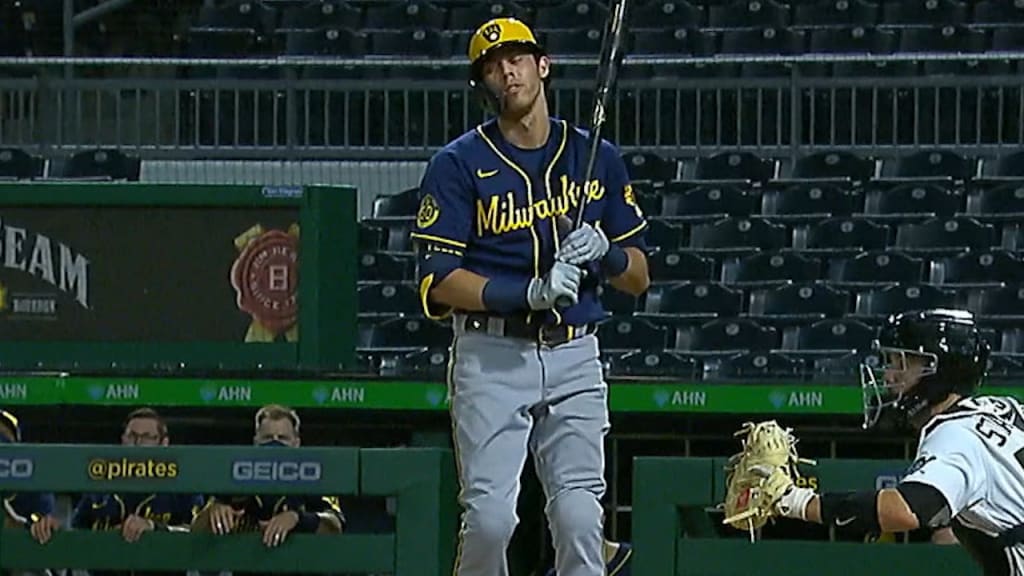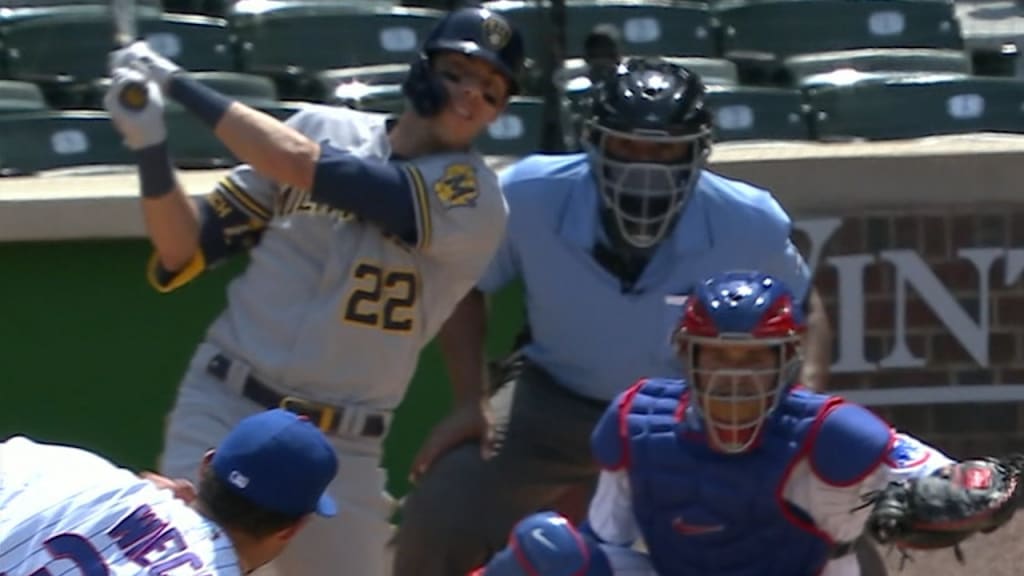Is Miller Park cure for Yelich's slow start?
This browser does not support the video element.
MILWAUKEE -- Perhaps some home cooking is what Christian Yelich needs to snap out of his uncharacteristic slump.
The National League leader over the past two seasons in wins above replacement, batting average, on-base percentage, slugging percentage, weighted runs created plus and weighted on-base average, Yelich returned from Milwaukee’s opening road trip as -- statistically speaking -- the least valuable player in Major League Baseball so far in 2020.
On one hand, it’s a small sample. That bears repeating, because it is important: It is a small sample, not predictive of what lies ahead for a player who has proven to be one of the sport’s best hitters. On the other hand, the 2020 season itself is a small sample. As the Brewers prepared to play their home opener, now rescheduled for Saturday after positive COVID-19 tests among the Cardinals, already 10 percent of the 60-game regular season schedule is complete.
And here’s the thing: Yelich himself predicted this could happen.
“I think this year is unique in the aspect of you just don’t know what you’re going to get from anybody,” he said at the start of July as the Brewers gathered for Summer Camp. “You’re going to see really good players have really bad years. It’s going to happen.
“Not only position player-wise, but pitcher-wise. You don’t have that large sample size for everything to even out, so if you get off to a tough start or a bad start, you’re really behind the 8-ball. Not only as a player, but if your team gets off to a bad start … you’re in a tough position because you don’t have the extended period of time to make that up. During a normal season, you’re going to go the 2-for-10 or 2-for-8 or 1-for-9. It’s going to happen. But if it happens this season right off the bat, it’s going to be tough to make up that ground.
Those were prescient words, but Yelich probably never envisioned it happening to him.
Here are the numbers: On the Brewers’ six-game opening road trip, Yelich was 1-for-27 with 12 strikeouts. Of MLB’s 174 qualifying hitters, Yelich’s -0.5 fWAR ranks last. After winning the NL batting title in each of the past two seasons – making him the first batting champion in Brewers history – Yelich’s .037 batting average ranks last. Only Danny Santana of the Rangers has a lower wRC+ (-67 to Yelich’s -43). Only Ronald Acuña Jr. of the Braves has struck out more (13 whiffs to Yelich’s 12). Yelich has multiple strikeouts in five of his first six games and already has a pair of three-strikeout games, including in an 0-for-5 night Wednesday in Pittsburgh. During all of last season, he had only six games with three strikeouts.
Last year, Yelich was in the 99th percentile in expected weighted on-base average -- a Statcast metric that calculates what a player’s output should be based on exit velocity, launch angle and, on certain types of batted balls, Sprint Speed -- and was in the 99th percentile in expected slugging percentage and in the 96th percentile of hard-hit percentage. He was in the 97th percentile in “barrels,” Statcast’s category for the ideal combination of velocity and launch angle.
So far this year, Yelich is in the 27th percentile in xwOBA, the the 47th percentile in xSLG, the 38th percentile in hard-hit percentage and the 57th percentile in barrels. His one hit was a two-run homer vs. the Cubs in the second game of the season.
This browser does not support the video element.
That he is in the top half of MLB in barreling the baseball, with so little to show for it, is evidence of some instances of bad luck. On Wednesday night alone, Yelich was called out on strikes on a Robbie Erlin curveball that appeared well below the zone. In his next at-bat, Yelich scorched a ball at 105.5 mph toward the middle of the field, and saw it go right to the Pirates second baseman for a groundout.
It’s a continuation of a quiet Spring Training and Summer Camp. If you combine his at-bats in the Cactus League, the Brewers’ intrasquad series at Miller Park and an exhibition at the White Sox before Opening Day, Yelich was 4-for-34 with 16 strikeouts while tuning up for the regular season.
“I don’t know what you want me to say here. He’s struggling,” Brewers manager Craig Counsell said. “We’re always concerned when our hitters struggle. He’ll get out of it. I assure of it. We’ll do our best to help him.”
Yelich is not only star hitter off to a quiet start. On Fangraphs’ WAR leaderboard, you’ll find the likes of Josh Bell and Kris Bryant with Yelich in the bottom five, Edwin Encarnacion, Alex Gordon, Miguel Cabrera and Andrew Benintendi in the bottom 15, and George Springer and Acuña in the bottom 20.
The Brewers hope Yelich’s turnaround begins Friday, when the Cardinals are the opponent for the 20th and final home opener at “Miller Park” before the stadium is renamed in 2021. It begins a stretch of 17 scheduled games in as many days, starting with five games at the venue where Yelich has done the bulk of his damage in a Brewers uniform, hitting 61 percent of his home runs in the past two seasons in home games, with a .699 slugging percentage at home versus .569 on the road.
Without fans in the stands, the Brewers will have to create some atmosphere. During their intrasquad series, a scoreboard operations employee sat at a folding table on the loge level in the seating bowl, working in iPad from MLB that was loaded with crowd effects. That means for the first time, the Brewers will hear regular season cheers in 2020.
The Brewers have other elements in mind for the home opener. With no ceremonial first pitches, they will have “ceremonial first cheers” on the scoreboard, starting with Bob Uecker and Brewers founder Bud Selig on Friday, to be followed by the likes of Robin Yount, Cecil Cooper, Corey Hart and high-energy former Brewers outfielder Nyjer Morgan. The children of Brewers players will call “Play Ball!” via video for each home game, and 11-year-old Liamani Segura, a ballpark favorite who comes from a family of health care workers, will sing the National Anthem on Friday.
There will even be a Sausage Race in the sixth inning, albeit remotely. The Brewers took suggestions from fans for venues and have been recording races to air during games.
“In a normal world, the audience would be the fans,” said Teddy Werner, the Brewers senior vice president of brand experience. “But what we’re trying to do is really help our players out and make this as normal an environment as possible.”
Still, this is all different, Werner acknowledged.
Counsell said the same.
“If you guys were in Chicago, you felt it on their Opening Day,” Counsell said. “It's different. I think the players are starting to settle into that, but I think they're still a little shocked by how different it all is. … It feels odd standing on the line and getting announced when there's nobody there. It was a strange experience in Chicago. You saw some guys waving into the camera, waving to fans trying to make some fun out of it. Everybody, on both sides, was kind of laughing at each other just trying to have some fun with it.”

